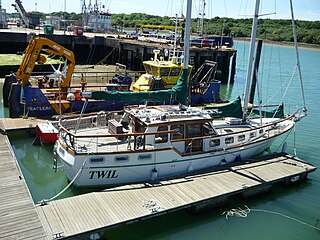
A sailing yacht, is a leisure craft that uses sails as its primary means of propulsion. A yacht may be a sail or power vessel used for pleasure, cruising, or racing. There is no standard definition, so the term applies here to sailing vessels that have a cabin with amenities that accommodate overnight use. To be termed a "yacht", as opposed to a "boat", such a vessel is likely to be at least 33 feet (10 m) in length and have been judged to have good aesthetic qualities. Sailboats that do not accommodate overnight use or are smaller than 30 feet (9.1 m) are not universally called yachts. Sailing yachts in excess of 130 feet (40 m) are generally considered to be superyachts.

The C&C 37/40 is a Canadian 12.05 metres (39.5 ft) LOA fibreglass monohull sailing yacht, designed in 1988 by Robert W. Ball of Cuthbertson & Cassian as a replacement for the earlier C&C 37 dating from 1981. The C&C 37/40 is a recreational keelboat of moderate displacement, intended as a cruiser/racer or oceangoing racer. The yachts have a masthead sloop rig, with a fin keel and an internally-mounted spade-type rudder. Over 110 of the 37/40 type were built before the Canadian plant closed in 1994. The design is no longer produced.
The C&C 44 and the C&C 44 Custom are a series of Canadian sailboats, that were designed by Robert W. Ball and first built in 1985.

The C&C Custom 62 is a Canadian sailboat, that was designed by Robert W. Ball of C&C Design for long range cruising and first built in 1981.
The Landfall 38 is a sailboat that was designed by Robert W. Ball, the chief designer of C&C Design and first built in 1979. The Landfall series, begun with the Landfall 42, was part of a trend within C&C Yachts to develop more cruising-oriented designs under company president George Cuthbertson's direction during the later 1970s and early 1980s.
The Landfall 43 is a sailboat that was designed by Robert W. Ball, the chief designer of C&C Design, and first built in 1982. The Landfall 43 was built with the charter trade in mind, to compete with Morgan and Whitby’s centre cockpit models. The Landfall series, begun with the Landfall 43's predecessor the Landfall 42, was part of a trend within C&C Yachts during the later 1970s and early 1980s to develop more cruising-oriented designs under company president George Cuthbertson's direction.
The Marlow-Hunter 50 is an American sailboat that was designed by the Hunter Design Team as a cruiser and first built in 2010.
The Marlow-Hunter 31 is an American sailboat that was designed by Glenn Henderson as a cruiser and first built in 2015.
The Marlow-Hunter 37 is an American sailboat that was designed by Glenn Henderson as a cruiser and first built in 2014.
The Marlow-Hunter 47 is an American sailboat that was designed by the Hunter Design Team as a cruiser and first built in 2016.
The Island Packet 29 is an American sailboat that was designed by Robert K. Johnson as a cruiser and first built in 1981.
The Catalina 375 is an American sailboat that was designed by Gerry Douglas as a cruiser and first built in 2008.
The Niagara 31 is a Canadian sailboat that was designed by Germán Frers as a racer/cruiser and first built in 1977.
The Caliber 40 is an American sailboat that was designed by Michael McCreary as a cruiser and first built in 1992.

The Nauticat 44 is a Finnish motorsailer sailboat that was designed by Kaj Gustafsson as a cruiser and first built in 1974.
The Worldcruiser 44 is an American sailboat that was designed by Bud Taplin as a cruiser and first built in 1980.
The Bayfield 29 is a Canadian sailboat that was designed by Ted Gozzard as a cruiser and first built in 1978.
The Archambault A40RC is a French sailboat that was designed by Joubert Nivelt Design as a racer-cruiser.
The Fisher 25 or Fisher 25 MS is a British trailerable pilothouse sailboat that was designed by Wyatt and Freeman as a cruiser and first built in 1974.
The Seaward 46RK is an American sailboat that was designed by Nick Hake as a cruiser and first built in 2012.





